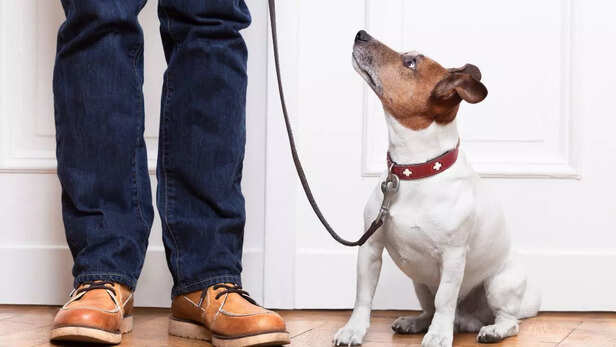Separation Anxiety in Pets: What it is and how to help
News Desk | May 06, 2025, 15:22 IST
How to help your pet cope with separation anxiety
Separation anxiety in pets is a common issue where animals experience stress when left alone. This article explains what separation anxiety in pets looks like, common triggers, and practical ways to help your furry companion feel safe and calm. From routine-building to professional help, discover effective strategies to ease your pet’s anxiety and support their emotional well-being.
Just like humans, our pets (especially cats and dogs) are also deeply attached to their owners. And so, when their owners leave, pets too experience separation anxiety. It is quite common in pets and it’s a condition where animals become extremely distressed when left alone or separated from their owners. Dogs are particularly prone to this, but pet cats, and even pet birds can suffer from it too.
Signs of separation anxiety
Separation anxiety is an emotional response our pets often give to being apart from a loved one—usually the pet's primary caregiver or owner. When left alone, anxious pets may display behaviours such as excessive barking or meowing, destructive chewing or scratching, pacing, house soiling, or attempts to escape. Some may even stop eating and show signs of depression.
![How to help your pet cope with separation anxiety]()
How to help your pet cope
1. Set a calm routine
Having a predictable and calm routine for feeding, playtime, or bathroom breaks, cann make pets feel safe and secure. This is because they know what to expect and at what time.
2. Practice short breaks
Instead of simply leaving your pet alone for longer durations, which might make them feel abandoned, leace your pet alone for just a few minutes and gradually increase the time. This will teach them that you will always come back.
3. Don’t make a big deal of goodbyes or hellos
Avoid dramatic farewells and over-the-top greetings-- as this would make your pet anxious about it.
4. Distract them
Toys, treat puzzles, or a piece of your clothing with your scent can keep your pet occupied and comforted in your absence.
![How to help your pet cope with separation anxiety]()
5. Create a safe space for your pet
Designate a cozy area where your pet feels secure. This could be a favourite bed, toy, or a quiet room-- all to calm them down when they feel anxious.
And if nothing works, do consult a vet or pet behaviourist. In some cases, anti-anxiety medications or training may be necessary to help your pet deal with separation anxiety.
Signs of separation anxiety
Separation anxiety is an emotional response our pets often give to being apart from a loved one—usually the pet's primary caregiver or owner. When left alone, anxious pets may display behaviours such as excessive barking or meowing, destructive chewing or scratching, pacing, house soiling, or attempts to escape. Some may even stop eating and show signs of depression.

How to help your pet cope with separation anxiety
How to help your pet cope
1. Set a calm routine
Having a predictable and calm routine for feeding, playtime, or bathroom breaks, cann make pets feel safe and secure. This is because they know what to expect and at what time.
2. Practice short breaks
Instead of simply leaving your pet alone for longer durations, which might make them feel abandoned, leace your pet alone for just a few minutes and gradually increase the time. This will teach them that you will always come back.
3. Don’t make a big deal of goodbyes or hellos
Avoid dramatic farewells and over-the-top greetings-- as this would make your pet anxious about it.
4. Distract them
Toys, treat puzzles, or a piece of your clothing with your scent can keep your pet occupied and comforted in your absence.

How to help your pet cope with separation anxiety
5. Create a safe space for your pet
Designate a cozy area where your pet feels secure. This could be a favourite bed, toy, or a quiet room-- all to calm them down when they feel anxious.
And if nothing works, do consult a vet or pet behaviourist. In some cases, anti-anxiety medications or training may be necessary to help your pet deal with separation anxiety.
- How to stop worrying about your pet?
Worrying about your pet is natural, but building a consistent routine and ensuring they’re safe, stimulated, and well cared for can ease your mind. Trust in your preparation and focus on quality time when you're together. - Is there a dog training app for separation anxiety?
Yes, there are dog training apps specifically designed to help with separation anxiety. Apps like Be Right Back!, Calm My Dog, and Solo Serenity offer step-by-step programs, progress tracking, and expert guidance to gradually reduce anxiety and help dogs feel more comfortable when left alone. - How can I calm my dog's anxiety naturally?
To calm your dog's anxiety naturally, create a consistent routine, provide plenty of exercise, and offer calming environments with soft bedding and soothing scents like lavender. You can also try using puzzle toys, calming music, and gentle massages. Regular companionship and positive reinforcement help reduce stress over time. - How to relieve dog separation anxiety?
To relieve dog separation anxiety, establish a consistent routine, gradually increase alone time, and create a calm environment with familiar scents and toys. Use positive reinforcement when they’re calm, and avoid dramatic goodbyes or arrivals. In severe cases, consider consulting a veterinarian or pet behaviorist for additional strategies.
Discover expert advice and the latest tips on pet care, training, health, and more. Stay updated with all things pets at Times Pets!
